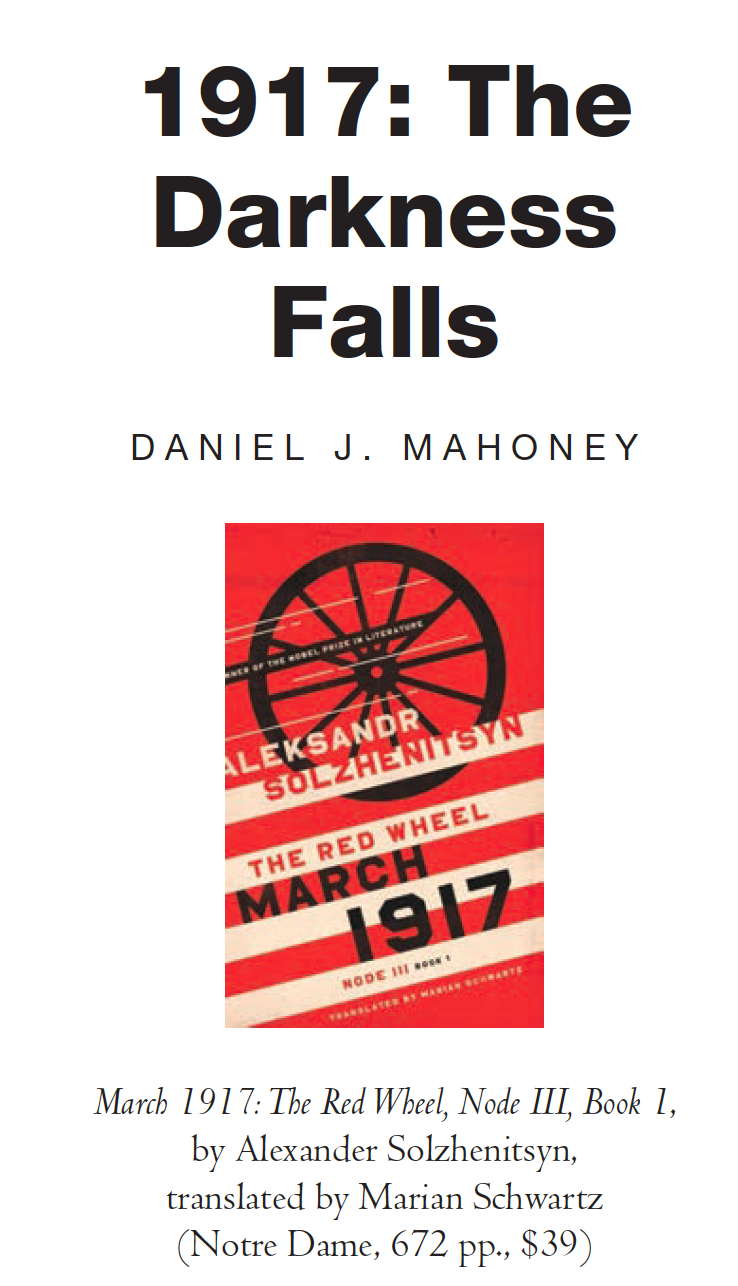1917: DARKNESS FALLS
/Daniel J. Mahoney's review of March 1917, Book 1 (originally appearing in National Review) has been re-published today at VoegelinView.
Daniel J. Mahoney's review of March 1917, Book 1 (originally appearing in National Review) has been re-published today at VoegelinView.

The opening of a new exhibition, "Solzhenitsyn at 100: Celebrating the Life and Work of Aleksandr Solzhenitsyn in Honor of his 100th Birthday", will take place on Saturday, May 19th at the Vermont Historical Society Museum in Montpelier. The exhibit, which will run through the summer, outlines the writer's life with a focus on the twenty years that he and his family called Vermont home (1975-1994).
Prior to the exhibit's official opening, on Thursday, May 17th, University of Vermont Professor Kevin J. McKenna will be the guest speaker at a luncheon hosted by the museum. His talk is entitled, "No Man Is a Prophet in His Own Land’: Russia’s Loss Has Been Vermont’s Gain.” McKenna will present a general introduction to Solzhenitsyn and his life in Cavendish, as well as what his presence in Vermont meant for Vermonters.
This is the Vermont History Museum's "Third Thursday Talk" for May. The presentation will begin at 12:00pm; coffee & water will be provided. Organizers welcome attendees to bring lunch to eat while listening.
Attendees will have a chance to view the Solzhenitsyn exhibit, which officially opens Saturday, May 19th.

Natalia Solzhenitsyn, the author's widow, who was in Paris for the Paris Book Fair, has given an extended interview to Le Figaro. Read the English translation here, or the original here. Mrs. Solzhenitsyn talks about her life with the author, his love of France, his work on the Russian Revolution, and the current state of relations between Russia and the West.
“Russia is going through a period that no other country has ever been through. It needs help, but not dictatorial and condescending help, as the United States has been doing with the IMF. The great mistake of the U.S. was to think that it had won the Cold War and that Russia would no longer be a player. A catastrophic approach! Because when pressured Russia bounces back like a spring. It felt humiliated, encircled. Much of the support for Putin can be explained by this feeling of humiliation. [One can] be firm with Russia, but issuing ultimatums is totally counterproductive.”
On March 21st, the Vermont General Assembly passed a resolution in Aleksandr Solzhenitsyn's honor. Ignat Solzhenitsyn and representatives of Cavendish, Vermont were on hand in Montpelier to be presented with official copies of Resolution HCR-199.
“No. R-248. House concurrent resolution commemorating the 100th anniversary of the birth of the Russian author, historian, and former Cavendish resident Aleksandr Isayevich Solzhenitsyn.”


March 1917: The Red Wheel, Node III, Book 1 was selected by the Association of University Presses for the 2018 Book, Jacket, and Journal Show. Jeff Miller, a designer with Faceout Studio, and Wendy McMillen, production and design manager of the University of Notre Dame Press, collaborated on the design. The design was one of 53 chosen from a total of 375 submissions. The show is held each year to celebrate the year's best work in design and production in university presses. The show will be exhibited across the U.S. from June 2018 to May 2019; the first show opens June 17th in San Francisco during the 2018 AUPresses Annual Meeting
Since 1965, the Association of University Presses has held the Book, Jacket, and Journal Show each year to highlight achievements in design and production in university presses. The winning books and journals for 2018, selected by jurors in New York City, will be displayed in the annual catalog and the traveling show, which premiers in San Francisco on June 17, and continues throughout North America until May 2019.
This year's annual meeting of the American Association of Teachers of Slavic and East European Languages (AAATSEEL) took place on February 3rd in Washington, D.C, where Professor Kevin McKenna of University of Vermont presented a lecture entitled, “‘What Men Live By’: Leo Tolstoy’s Proverb-Parable As a Source for Aleksandr Solzhenitsyn’s Novel, Cancer Ward.”
McKenna's paper will be published at a later date.

On January 23rd, author and historian Margo Caulfield led a book discussion of One Day in the Life of Ivan Denisovich in Ludlow, Vermont at Fletcher Memorial Library.
Caufield is the author of Aleksandr Solzhenitsyn: The Writer Who Changed History, an introduction to Solzhenitsyn's life and writings, published in 2016.

On 17 January, the Union of Moscow Architects announced the project winner, Andrei Nikolaevich Kovalchuk, selected by their jury from a Russia-wide field of design projects competing to build the new Solzhenitsyn monument on ul. Solzhenitsyna (Solzhenitsyn Street) in Moscow in connection with the writer’s upcoming centennnial.

The Winning Design
solzhenitsyn.ru
Guy Burnett reviews March 1917, Book 1 in tandem with Catherine Merridale's Lenin on the Train.
“There was no shortage of blame, but Solzhenitsyn shows how the most dangerous blunders leading up to October 1917 were the Czar’s. He presents Nicholas II as a naïve but devoted family man, a great neighbor but poor leader, whose faith in the protestors was his undoing.”
The novelist Jeff Bursey reviews March 1917, Book 1, suggesting that it is very much a modernist novel, even as History herself emerges as a "skillfully drawn character in this portrait of Russia on the eve of its transformation".
“What we have, so far, of Aleksandr Solzhenitsyn’s mega-novel The Red Wheel is correspondingly inventive, despairing, sharp, acidic, lyrical, and panoramic, with shafts of insight illuminating murky or forgotten corners.”


The Red Wheel, Node III, March 1917, Book 1 is available today for the first time in English from University of Notre Dame Press, from Amazon, or wherever books are sold.
We remind Solzhenitsyn readers of the overall sequence of the 10-volume Red Wheel:
Node I: August 1914, Books 1 & 2 (Farrar, Straus & Giroux, published in one volume)
Node II: November 1916, Books 1 & 2 (Farrar, Straus & Giroux, published in one volume)
Node III: March 1917, Book 1 (University of Notre Dame Press)
Node III: March 1917, Book 2 (forthcoming 2019—University of Notre Dame Press)
Node III: March 1917, Book 3 (forthcoming—University of Notre Dame Press)
Node III: March 1917, Book 4 (forthcoming—University of Notre Dame Press)
Node IV: April 1917, Book 1 (forthcoming—University of Notre Dame Press)
Node IV: April 1917, Book 2 (forthcoming—University of Notre Dame Press)
To inform readers about Solzhenitsyn’s system of “Nodes”, and also to explain the definitive term “Node” (instead of the older “Knot”), here is a portion of the Publisher’s Note that accompanies each of the Notre Dame volumes:
The English translations by H.T. Willetts of August 1914 and November 1916, published by Farrar, Straus and Giroux in 1989 and 1999, respectively, appeared as Knot I and Knot II. The present translation, in accordance with the wishes of the Solzhenitsyn estate, has chosen the term “Node” as more faithful to the author’s intent. Both terms refer, as in mathematics, to discrete points on a continuous line. In a 1983 interview with Bernard Pivot, Aleksandr Solzhenitsyn described his narrative concept as follows: “The Red Wheel is the narrative of revolution in Russia, its movement through the whirlwind of revolution. This is an immense scope of material, and . . . it would be impossible to describe this many events and this many characters over such a lengthy stretch of time. That is why I have chosen the method of nodal points, or Nodes. I select short segments of time, of two or three weeks’ duration, where the most vivid events unfold, or else where the decisive causes of future events are formed. And I describe in detail only these short segments. These are the Nodes. Through these nodal points I convey the general vector, the overall shape of this complex curve.”
The Union of Moscow Architects has unveiled an exhibit of the various projects competing to be awarded the right to build a major monument to Solzhenitsyn in Moscow. The winner will be announced on 7th December.

A probing review of March 1917, Book 1, posted today.
“Solzhenitsyn has made this mob of characters and passions, this kinesis of revolution, intelligible. For this his work deserves to be read not only in Russia but everywhere. The thoughts of the characters, their understandable confusion, their elation or despair, come through without any resort to moral relativism. In scenes that parallel one another, Solzhenitsyn gives us mind after mind, capturing the insights but also the illusions of each. When he intervenes in his own voice he speaks not with narrative omniscience, which he leaves to God, but with narrative judgment, which as a Christian he shares a bit with God, thanks to God.”

Insightful review of March 1917, Book 1 from renowned Solzhenitsyn scholar Daniel J. Mahoney in the new issue of National Review.
“This volume consists of 170 chapters (out of 656 in March 1917 as a whole), most of them relatively brief. One experiences on every page the frenzied pace of events spiraling completely out of control.”

As reported by Digital Journal, The Solzhenitsyn Foundation and the Memorial organization have partnered in backing the creation of a new monument by sculptor Georgy Frangulyan, which was unveiled as a part of a memorial for Soviet-era victims of political repression in Central Moscow. Russian President Vladimir Putin spoke at the memorial's dedication and quoted Natalia Solzhenitsyn in his remarks.
“To know, to remember, to condemn and only then to forgive.”

The University of Note Dame Press has announced a major new Solzhenitsyn series, called The Center for Ethics and Culture Solzhenitsyn Series. March 1917: Red Wheel, Node III, Book 1, the first book in this series, will be published later this month. It is the continuation of Solzhenitsyn's epic Red Wheel novel, which begins with August 1914, then October 1916, and now March 1917.
The October 30th edition of the National Review featured an article, "The Russian Revolution, 100 Years On: Its Enduring Allure and Menace" accompanied by sidebars highlighting notable Russian authors. In one, Anne Applebaum, the Pulitzer-Prize-winning author of Gulag: A History, speaks to the influence of Solzhenitsyn's The Gulag Archipelago on the West.
“When we look back at the 20th century, Aleksandr Solzhenitsyn will be remembered not just as an influential author, but as one of the few authors who actually altered the way in which millions of people thought about politics. ”

Letitia Montgomery-Rodgers reviews March 1917, Book 1 at Foreword.
“In March 1917, Solzhenitsyn attempts the impossible and succeeds, evoking a fully formed world through episodic narratives that insist on the prosaic integrity of every life, from tsars to peasants. What emerges is a rich history that’s truly greater than the sum of its parts.”

James Pontuso, writing at the Victims of Communism blog: "Solzhenitsyn’s multi-volume The Red Wheel attempts to answer the question: why did the Russian Revolution occur?”
“It was in this chaotic situation that the peculiar talents of Vladimir Lenin came into play. Solzhenitsyn portrays Lenin throughout The Red Wheel as disciplined, self-assured, cunning, and ruthless.”

A review of March 1917, Book 1 by Gary Saul Morson in The New Criterion.
“In the final analysis, The Red Wheel is less a political novel than an anti-political novel […] To see life solely in political terms is to misunderstand it.”

The Aleksandr Solzhenitsyn Center
ASC Blog
His Writings
His Life
Landmarks & Exhibits
Photo galleries
Video Library
Resources
Donate
Contact Us
The Aleksandr Solzhenitsyn Center supports explorations into the life and writings of the Nobel Laureate and Russian writer and historian Aleksandr Solzhenitsyn.